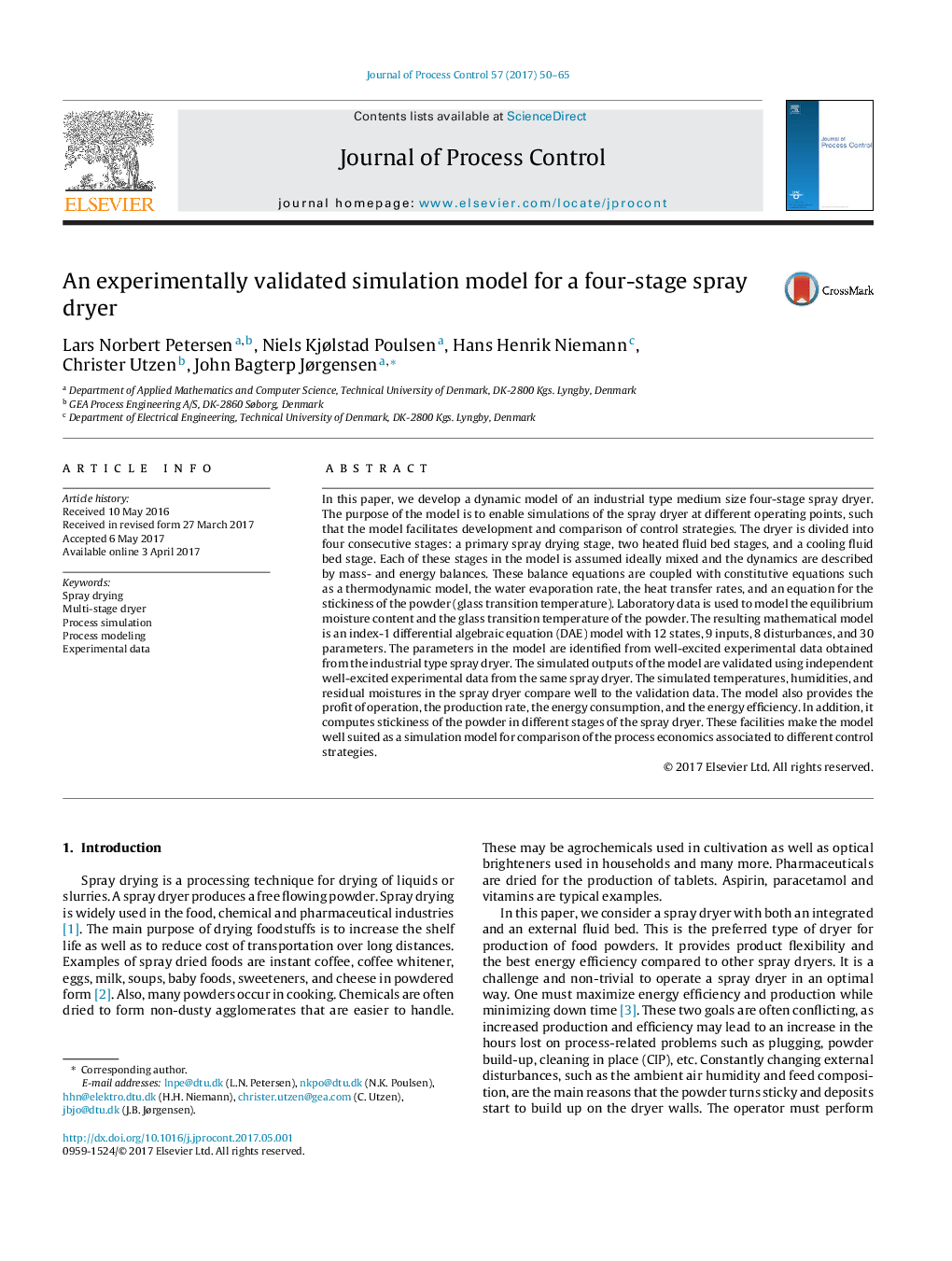| کد مقاله | کد نشریه | سال انتشار | مقاله انگلیسی | نسخه تمام متن |
|---|---|---|---|---|
| 4998407 | 1460346 | 2017 | 16 صفحه PDF | دانلود رایگان |
عنوان انگلیسی مقاله ISI
An experimentally validated simulation model for a four-stage spray dryer
ترجمه فارسی عنوان
یک مدل شبیه سازی آزمایشگاهی معتبر برای یک دستگاه خشک کن اسپری چهار مرحله ای
دانلود مقاله + سفارش ترجمه
دانلود مقاله ISI انگلیسی
رایگان برای ایرانیان
کلمات کلیدی
خشک کردن اسپری، خشک کن چند مرحله ای شبیه سازی فرآیند، مدل سازی فرآیند، داده های تجربی،
ترجمه چکیده
در این مقاله، ما یک مدل پویا از یک نوع اسپری خشک کننده چهار مرحله ای صنعتی صنعتی داریم. هدف از مدل این است که شبیه سازی خشک کن اسپری در نقاط عملیاتی مختلف را فعال کنیم، به طوری که مدل تسهیل توسعه و مقایسه استراتژی های کنترل را فراهم می کند. خشک کن به چهار مرحله متوالی تقسیم می شود: یک مرحله خشک شدن اسپری اولیه، دو مرحله رطوبت مایع گرم و یک مرحله بستر مایع خنک کننده. هر یک از این مراحل در مدل، به صورت ایده آل مخلوط شده و پویایی با توازن توده و انرژی توصیف می شود. این تعادل معادلات با معادلات سازنده مانند مدل ترمودینامیکی، سرعت تبخیر آب، نرخ انتقال حرارت و معادله ی چسبندگی پودر (دمای انتقال شیشه) همراه است. داده های آزمایشگاهی برای مدل رطوبت تعادل و دمای انتقال شیشه ای پودر استفاده می شود. مدل ریاضی حاصل یک مدل معادلات دیفرانسیل دیفرانسیل دیفرانسیل با 12 حالت، 9 ورودی، 8 اختلال و 30 پارامتر است. پارامترهای موجود در مدل از داده های آزمایشی به دست آمده از خشک کن اسپری خشک صنعتی بدست آمده است. خروجی های شبیه سازی شده از مدل با استفاده از داده های تجربی مستقل به خوبی تحریک شده از همان خشک کن اسپری معتبر است. دما، رطوبت، و رطوبت های باقی مانده در خشک کن اسپری، شباهت زیادی به داده های اعتبار سنجی دارد. این مدل همچنین سود عملیات، میزان تولید، مصرف انرژی و بهره وری انرژی را فراهم می کند. علاوه بر این، چسبندگی پودر در مراحل مختلف خشک کن اسپری را محاسبه می کند. این تسهیلات، مدل را به عنوان یک مدل شبیه سازی برای مقایسه اقتصاد فرایند مرتبط با استراتژی های کنترل مناسب، مناسب می سازد.
موضوعات مرتبط
مهندسی و علوم پایه
مهندسی شیمی
تکنولوژی و شیمی فرآیندی
چکیده انگلیسی
In this paper, we develop a dynamic model of an industrial type medium size four-stage spray dryer. The purpose of the model is to enable simulations of the spray dryer at different operating points, such that the model facilitates development and comparison of control strategies. The dryer is divided into four consecutive stages: a primary spray drying stage, two heated fluid bed stages, and a cooling fluid bed stage. Each of these stages in the model is assumed ideally mixed and the dynamics are described by mass- and energy balances. These balance equations are coupled with constitutive equations such as a thermodynamic model, the water evaporation rate, the heat transfer rates, and an equation for the stickiness of the powder (glass transition temperature). Laboratory data is used to model the equilibrium moisture content and the glass transition temperature of the powder. The resulting mathematical model is an index-1 differential algebraic equation (DAE) model with 12 states, 9 inputs, 8 disturbances, and 30 parameters. The parameters in the model are identified from well-excited experimental data obtained from the industrial type spray dryer. The simulated outputs of the model are validated using independent well-excited experimental data from the same spray dryer. The simulated temperatures, humidities, and residual moistures in the spray dryer compare well to the validation data. The model also provides the profit of operation, the production rate, the energy consumption, and the energy efficiency. In addition, it computes stickiness of the powder in different stages of the spray dryer. These facilities make the model well suited as a simulation model for comparison of the process economics associated to different control strategies.
ناشر
Database: Elsevier - ScienceDirect (ساینس دایرکت)
Journal: Journal of Process Control - Volume 57, September 2017, Pages 50-65
Journal: Journal of Process Control - Volume 57, September 2017, Pages 50-65
نویسندگان
Lars Norbert Petersen, Niels Kjølstad Poulsen, Hans Henrik Niemann, Christer Utzen, John Bagterp Jørgensen,
